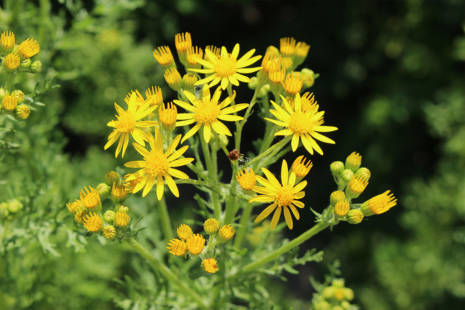Thursday 6th October, 2016

Ragwort is the nemesis of every horse and its owner and this highly poisonous plant can have devastating effects on horses when eaten in moderate quantities. Ragwort is toxic to horses and if even small amounts are eaten repeatedly over a relatively short time, the accumulated toxins causes irreparable damage to the liver, and ultimately organ failure.
The short answer is you won’t, particularly if you have recently bought the horse and know nothing of his previous grazing environment. Horses can appear perfectly fit and healthy even after eating the plant regularly, however it could only take one more mouthful to cause extreme symptoms including dramatic weight loss, imbalance, loss of co-ordination, lethargy, breathing difficulties and blindness to name but a few. The biggest problem with ragwort is that it is a silent killer, and once the symptoms are seen, it is often too late to save the horse and the only course of action is euthanasia.
Ragwort can be seen between May and October, with mature rosettes appearing from March/April onwards. When the plant dies it can produce thousands of down-covered seeds that germinate and are carried by the wind. Seeds also travel on animals, humans, by water or by wheelbarrow, so it is important that no ragwort plant is left to grow and mature to this level. If any seeds did escape, Ragwort seedlings often appear in the Autumn, so now is the perfect time to watch out and nip any seedlings in the bud from the off.
Sadly, there is no known cure for Sweet Itch at present and once they have developed the condition it very often gets progressively worse each year. Good stable management and equine husbandry is the key to stopping Sweet Itch in its tracks and the very best solution is prevention where possible. There are many ways to prevent Sweet Itch in horses and ponies however, most midges are drawn to water and breed on wetlands or in woodlands, so if you graze your equines near to standing water such as ponds or lakes or in wooded areas then why not consider moving him to a different site.
If you don’t have access to alternate grazing, you might consider stabling your horse in a well ventilated stable at dawn and dusk when the midges are most prevalent. Finally, if turning out is the only option available to you then invest in a light turnout rug complete with neck and tail guard, or a specially designed sweet itch rug that will protect these vulnerable areas from receiving unwanted bites.
Blanket removal of ragwort is actually not advised due to the plant’s importance as a source of nectar and pollen to over 150 species of bees, flies and butterflies, however it must be removed from high risk grazing areas. Keeping on top of ragwort in your paddocks is no easy task. Every responsible horse owner should check their fields regularly for ragwort and other poisonous plants or trees, however this can be a daunting task if you have several acres of land to scour. The British Horse Society provides a useful ragwort toolkit to help you recognise and deal with any ragwort plants in your paddock.
When removing ragwort, it is not enough to simply cut it down as this plant is just as toxic when dead as it is when alive. With this in mind, you must check any hay or haylage that you feed your horse, as cut ragwort loses its unpalatable taste and any that has been unknowingly baled will still provide a considerable risk to your horse. The ragwort plant is also harmful to humans, so before you embark on any removal missions make sure that you are gloved and gowned appropriately to protect your hands, arms and face when handling the plant.
Ragwort needs to be disposed of very carefully and the most effective way is to burn the plant to prevent the spread of the seeds. Despite thorough removal, ragwort control is an ongoing process. Ragwort seeds can remain in the ground for several years before germinating therefore the plants are likely to spring up again and again.